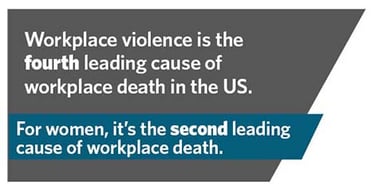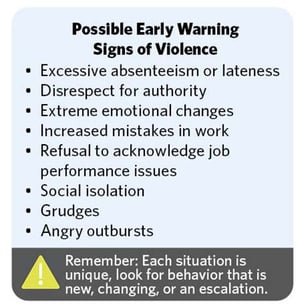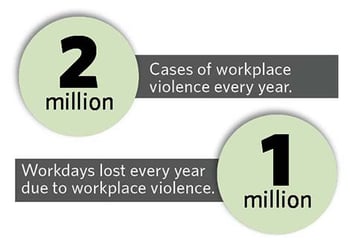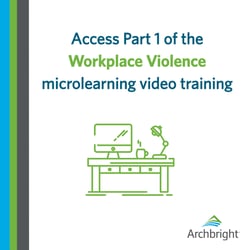Behavioral Threat Assessment in the Workplace: An Interview with Dr. Lynn Van Male
Workplace violence continues to be a serious concern for employers, and HR professionals and other business leaders must remain vigilant for...
5 min read
 Lindsey Sosa, SPHR, SHRM-CP and Tiffany Knudsen, SMS
:
Jun 15, 2022 6:15:26 PM
Lindsey Sosa, SPHR, SHRM-CP and Tiffany Knudsen, SMS
:
Jun 15, 2022 6:15:26 PM

The devastating school shooting at Uvalde, Texas, has caused many to ponder the likelihood of a mass shooting in a location where they spend time, such as work or school. The tragedy has prompted nationwide discussions about violence prevention, mental health resources, and survival strategies if a mass shooting should occur.
 Violence continues to be a genuine concern for employers and employees in the workplace. According to the Bureau of Labor and Statistics (BLS), workplace violence is the fourth leading cause of workplace death in the US and is the second leading cause of workplace death for women. Workplace violence is defined as any act or threat of physical violence, harassment, or intimidation, and it can come from anyone—customers, clients, co-workers, personal acquaintances, and even strangers. There are over two million cases of workplace violence every year, resulting in the loss of over one million workdays. The risk of workplace violence increases when employees work alone or in small groups, exchange money with the public, provide healthcare services, are in alcohol-serving environments, work at night, or work in higher-crime areas.
Violence continues to be a genuine concern for employers and employees in the workplace. According to the Bureau of Labor and Statistics (BLS), workplace violence is the fourth leading cause of workplace death in the US and is the second leading cause of workplace death for women. Workplace violence is defined as any act or threat of physical violence, harassment, or intimidation, and it can come from anyone—customers, clients, co-workers, personal acquaintances, and even strangers. There are over two million cases of workplace violence every year, resulting in the loss of over one million workdays. The risk of workplace violence increases when employees work alone or in small groups, exchange money with the public, provide healthcare services, are in alcohol-serving environments, work at night, or work in higher-crime areas.
There are several ways to decrease your organization’s workplace risk of a violent act. First, establish a policy that addresses workplace violence, including how and where employees should report suspicious or concerning behavior and examples of prohibited conduct. The policy should also contain a provision that employees who have obtained an order for victim protection that lists the company as their workplace must notify HR immediately.
Consider implementing a policy that prohibits weapons in the workplace or while employees are engaged in company business while off-premises. The policy should also apply to employees with a permit to lawfully carry firearms and weapons in personal vehicles on company premises.
In addition to establishing policies, conducting pre-employment criminal background checks may also limit your risk for workplace violence. Of course, not all individuals with a criminal past are guaranteed to commit another crime; similarly, not all violent outbursts can be predicted by past behavior. However, a person with a pattern of past violent behavior could be at risk of exhibiting the same conduct again. Keep in mind that employers should avoid a uniform application of policy in rejecting applicants for certain crimes and individually analyze each situation and how it relates to the intended position.
Another effective strategy to prevent violence in your organization is to stay in tune with your employees and identify individuals who appear to be struggling with extreme stress, anxiety, and/or depression. HR professionals should work with managers to determine the best way to intervene when employees exhibit these symptoms of adversity. In most cases, referring the employee to an Employee Assistance Program (EAP) is recommended. EAPs are employer-provided confidential programs designed to promote worker health, safety, and well-being. Services can include numerous employee resources such as free counseling sessions, legal and financial advice, eldercare services, wellness services, substance abuse treatment, and adoption assistance. The resources are generally available to employees and their family members. Employers who do not already provide an EAP to their employees are well-advised to do so, as the benefit cost is minimal and can prevent employee distress from escalating into something much more severe.
It’s important to remember that it can be difficult to predict when a person can become violent. Not all individuals will present with warning signs, and it’s important to keep their behaviors in context. Generally, early warning signs can include excessive absenteeism or lateness, disrespect for authority, extreme emotional changes, increased mistakes in work, refusal to acknowledge job performance issues, social isolation, grudges, and angry outburst. Although each situation is unique, employers are encouraged to use their best judgment in every situation. These behaviors can be concerning at any time, but intervention should be considered early, especially if the behavior is new, a change, or an escalation of a worker’s normal pattern.
Employers are generally not advised to require an employee to seek treatment through an EAP unless the circumstances are severe, for example, if the employee is making threats of violence or appears suicidal. Even still, taking adverse action against an employee who refuses a mandatory EAP referral may result in claims of disability discrimination. Employers faced with this situation should seek advice from an employment attorney before taking action.
 When an employee’s performance or attendance is not meeting expectations, HR professionals and managers should approach the situation with empathy rather than leading with discipline or termination. This tactic can often reduce legal claims and, in some cases, prevent workplace violence if they feel supported. Seek to understand the root cause of the deficiency. For instance, is the employee’s depression causing them to miss or be late to work? Are they dealing with a divorce or a death in the family? Are they a recovered alcoholic who has recently fallen off the wagon? Are they experiencing homelessness or domestic violence? The explanation for their work troubles could be due to numerous different personal problems. Or the problem could be caused by a deficiency in a work process, for example, lack of training, mismatch in skills upon hiring, or unclear communication from the employee’s supervisor. Once the root cause is identified, the most appropriate next steps can be determined, whether that’s a heart-to-heart conversation, providing resources, or, if need be, discipline.
When an employee’s performance or attendance is not meeting expectations, HR professionals and managers should approach the situation with empathy rather than leading with discipline or termination. This tactic can often reduce legal claims and, in some cases, prevent workplace violence if they feel supported. Seek to understand the root cause of the deficiency. For instance, is the employee’s depression causing them to miss or be late to work? Are they dealing with a divorce or a death in the family? Are they a recovered alcoholic who has recently fallen off the wagon? Are they experiencing homelessness or domestic violence? The explanation for their work troubles could be due to numerous different personal problems. Or the problem could be caused by a deficiency in a work process, for example, lack of training, mismatch in skills upon hiring, or unclear communication from the employee’s supervisor. Once the root cause is identified, the most appropriate next steps can be determined, whether that’s a heart-to-heart conversation, providing resources, or, if need be, discipline.
 No one’s safety should ever be jeopardized. Employers must take immediate action if an employee’s behavior escalates and they start making threats or displaying intimidating behavior. Employers should follow their policy and procedures for responding to workplace bullying, harassment, and violence. If employers don’t have a policy or identified procedures, or it’s been a while since they’ve been reviewed, now is the time to act. Employers should also ensure that employees know and understand these policies. Although employers want to avoid workplace gossip, they should ensure that employees understand how to report concerns.
No one’s safety should ever be jeopardized. Employers must take immediate action if an employee’s behavior escalates and they start making threats or displaying intimidating behavior. Employers should follow their policy and procedures for responding to workplace bullying, harassment, and violence. If employers don’t have a policy or identified procedures, or it’s been a while since they’ve been reviewed, now is the time to act. Employers should also ensure that employees know and understand these policies. Although employers want to avoid workplace gossip, they should ensure that employees understand how to report concerns.
All employees should be trained to recognize potential workplace violence threats and take them seriously. Training includes not only potential warning signs and how to respond to an event but also how to take precautions to help keep themselves and others safe. Key precautions include:
When training employees on handling workplace violence situations, ensure they know to secure their safety first in threatening situations. In the event of a workplace violence situation, workers should:
If the aggressor is armed, the workers should not attempt to de-escalate the situation. Instead, they should:
After an event, employees exiting the facility should walk outside with their hands up and empty or wait for local law enforcement officers to assist in exiting the building. All employees should follow check-in procedures and participate in follow-up investigations as requested. Employees should feel welcome to contact their employer with questions or concerns or to gain assistance if needed. Employers should contact their EAP immediately after an event to set up onsite counseling for workers.
Workplace violence can be stressful for all involved. Taking appropriate actions to plan and prepare for events can help prevent and limit the impact.

Archbright members have access to tools and resources to help them prevent and respond to workplace violence, including Workplace Violence Keynote, Violence in the Workplace Policy, a sample Weapons Policy, and Workplace Violence microlearning video training. Archbright members with additional questions or who need assistance with workplace violence programs can contact our Safety Hotline through email or chat.
Not an Archbright member? Access Part One of the Workplace Violence microlearning video here.

Workplace violence continues to be a serious concern for employers, and HR professionals and other business leaders must remain vigilant for...

An employer has a duty to conduct a prompt and thorough investigation of alleged acts of harassment, discrimination, workplace violence, or when they...

The Occupational Safety and Health Administration (OSHA) officially announces its top ten most frequently cited standards every April for the...